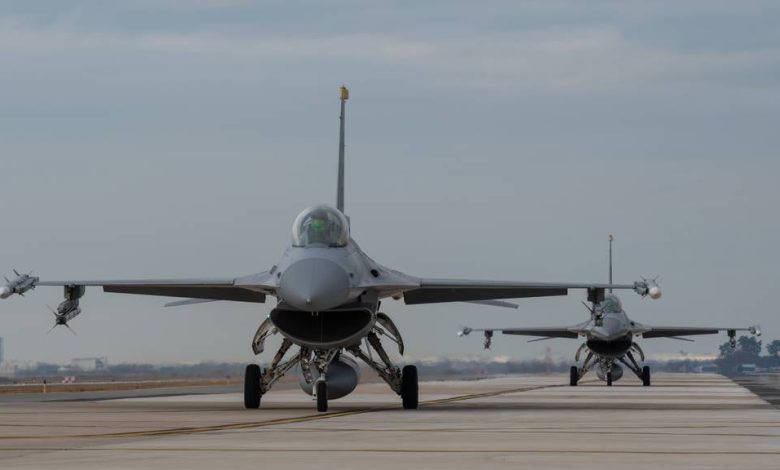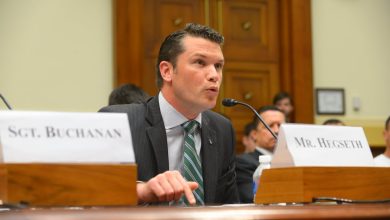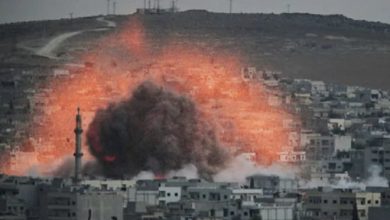F-16s to be ‘flying in the skies of Ukraine this summer,’ US says

More than two years into the full-scale war with Russia, Ukraine is closer than ever to its coveted F-16 jets.
In a statement Wednesday, American, Danish and Dutch leaders said the “transfer process” for the fourth-generation fighters is “underway.”
“Those jets will be flying in the skies of Ukraine this summer to make sure that Ukraine can continue to effectively defend itself from the Russian aggression,” U.S. Secretary of State Antony Blinken said at a NATO event in Washington.
However, Justin Bronk, an air power analyst at the London-based Royal United Services Institute think tank, cautioned the statement may simply suggest a change of ownership rather than a state of combat readiness. The Ukrainian Air Forces may now go from training on jets held and operated by the Netherlands and Denmark to having custody of some.
“I highly doubt they would make a public statement about it” if the F-16s were immediately moving onto Ukrainian airfields, Bronk said.
The reason for that could be safety. In the last week, Bronk noted, Russia has targeted four Ukrainian airfields with ballistic missiles — guided by aerial drones that Ukrainian forces apparently lacked the interceptors to take down. It’s unclear how many actual planes, as opposed to decoys, Kyiv lost.
But the attacks are a reminder of a much larger challenge for Ukraine, Bronk said: Without enough air defense, its military can’t use F-16s anywhere near their full potential.
To wit, U.S. President Joe Biden opened the NATO summit on Tuesday by announcing an agreement with four other countries to send Ukraine more air defense batteries.
The U.S., the Netherlands and Denmark lead a group of countries that helps provide Ukraine with air power. The Danish and Dutch governments first agreed to send Ukraine the jets last year, and other countries, including Norway and Belgium, have since joined. The number thus far pledged to Ukraine is about 65.
Norwegian officials on Wednesday clarified that Oslo’s contribution would cover six F-16s. “We plan to start delivering the aircraft in the course of 2024,” Prime Minister Jonas Gahr Støre said in a statement.
Belgian Prime Minister Alexander De Croo said earlier this year his country would donate 30 planes. The Netherlands has promised 24, according to Reuters.
It was at last year’s NATO summit in Vilnius, Lithuania, where countries initially agreed to start training Ukrainian pilots to fly the fighters. One of the most difficult challenges has been a language barrier, since the jargon used by pilots and crews is highly technical and there’s no time to clarify a word mid-flight.
According to the Pentagon, there are just over 12 Ukrainian pilots training to fly the jets between Denmark and the U.S. right now. While a handful graduated from the course in late May, the number in the pipeline is too small, some Ukrainian officials argue.
“If we’re expected to have up to 20 machines by the end of the year, we need pilots,” Igor Zhovkva, an adviser to Ukrainian President Volodymyr Zelenskyy, said in an interview. “We are asking now [from] all of our partners for two things: to increase the number of places for training, because currently it is not enough, and secondly to optimize the period of training” — essentially speed it up.
One of the main issues with increasing that capacity is the long queue of countries already waiting for the U.S. Air Force to train their pilots. Yehor Cherniev, who leads Ukraine’s parliamentary delegation to NATO, told Defense News that he and other lawmakers asked Congress for a list of those nations so Ukraine can negotiate with them to swap spots.
American lawmakers didn’t agree to do so, he said.
The F-16s have long been a priority for Ukraine. Receiving them may help with morale and the country’s actual defense.
In the medium term, they could also pair well with two airborne surveillance planes Sweden pledged for Ukraine at the start of the summer. These can help the Ukrainian Air Forces with targeting as well as command-and-control, Swedish Defence Minister Pål Jonson said in an interview.
“That’s the difference between a third-generation fighter, which the Ukrainians are operating, and the fourth-generation fighter,” he said.
For his part, Bronk questions how Ukraine will train on and then operate these surveillance planes. They will need experienced Ukrainian crews and then must pair them with pilots who have expertise on the F-16 before there is a positive effect for the embattled country, Bronk said.
“Where are they going to fly from? Who’s going to maintain them? And are they going to fly and operate inside Ukraine, or are they going to fly around the borders?” he added.
Noah Robertson is the Pentagon reporter at Defense News. He previously covered national security for the Christian Science Monitor. He holds a bachelor’s degree in English and government from the College of William & Mary in his hometown of Williamsburg, Virginia.







